From talking to some of my contacts in the know, it certainly sounds like that the sport of cricket is in the ascendancy once again.
The recent successes of both the England men's and women’s teams, along with the start of this year’s Ashes for both (despite the men’s hard fought loss at Edgbaston and the women under the pump today at Trent Bridge), seems to have acted as a catalyst for the sudden upturn in interest in the sport. Many clubs are reporting a boost in numbers playing the game.

The first Ashes test underway at Edgbaston - photo courtesy of Mark Allen
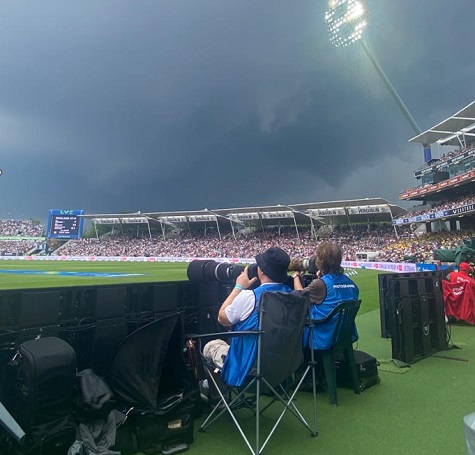
Rain stops play at Edgbaston - photo courtesy of Mark Allen
From reading many the socials of cricket turf professionals, it has certainly been a tough year for the preparation and maintenance of pitches. The fact that we had a dry February, followed by a wet March / April and then the weather during May and June drying up, has posed a few issues for teams preparing and maintaining their pitches. We are now in the midst of the playing season, with air temperatures recorded in the high twenties, thus drying out the playing surfaces dramatically. Unless you have covers / watering facilities, it is going to be a difficult time for many grassroots clubs to maintain their pitches effectively.
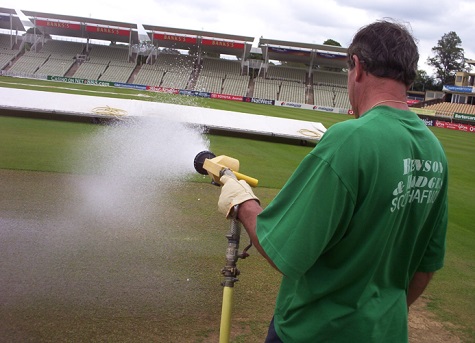
Steve Rouse HG, watering a pitch at Edgbaston, 2004
Preparing natural grass cricket pitches requires careful attention to detail and several key steps as part of a ten-day pitch preparation.
Of all the natural turf playing surfaces the preparation of a cricket pitch does take the most time to prepare. Usually the norm is effectively a ten day period of work to get it ready for a match.
Preparing a cricket wicket, also known as pitch preparation, is a meticulous process that involves several steps and considerations. The exact methods can vary depending on the specific conditions, requirements and indeed the weather conditions prevailing at the start of the pitch preparations.
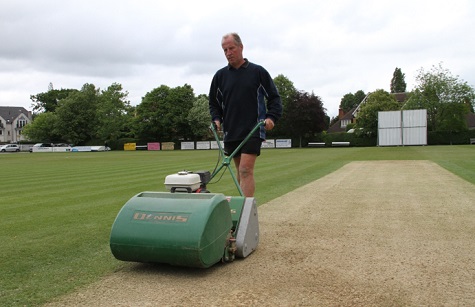
Mowing the pitch a Knowle & Dorridge CC
The existing grass cover is trimmed to an appropriate length, considering factors like weather, desired pace, and bounce. The soil is thoroughly rolled and leveled using heavy rollers and machinery to create a smooth and compact surface. This helps ensure consistent bounce and pace.
Controlled watering is carried out to ensure proper moisture levels are achieved for the desired balance, as different pitches require varying levels of moisture for optimal playability.
The pitch is repeatedly rolled using heavy rollers to further compact the soil, eliminate air pockets, and provide a hard and even surface. This process aids in achieving good pace and bounce during the match.
To help protect the prepared pitch from external factors like rain, dew, or extreme weather, appropriate pitch covers are used. This helps maintain the integrity of the surface until the match begins.
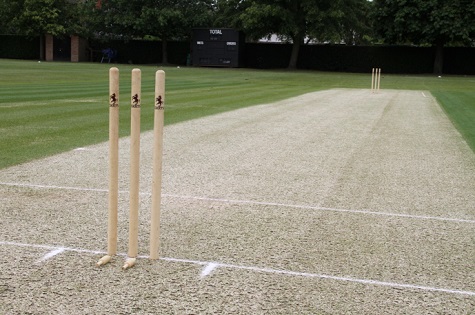
Prepared pitch at Blue Cote School
Throughout the ten-day process, the ground staff continually monitors and adjusts the pitch's moisture, firmness, and other conditions to achieve the desired playing characteristics. The goal is to provide a fair and balanced surface that offers a contest between batsmen and bowlers.
Over the course of the allotted ten days, a series of tasks are undertaken. A pitch or track is selected for use and as part of the preparation the height of grass will be reduced over several days from the squares regularly maintained height (15mm-12mm) down to anything between 8mm-5mm. In recent years we have seen a move to leave more grass on the wickets to help with obtaining consistent pace and bounce - and more importantly allow the grass to recover more quickly after games. Also during this time, a series of raking and scarification work will be done to thin out and remove any excess debris from the pitch.
This will be coupled with some ongoing rolling to help consolidate the pitch and firm it up for the match. If you have covers these can be used to control the drying out or maintain levels of moisture in the pitch.
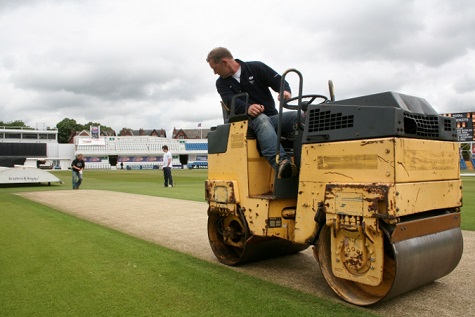
Rolling at Headingley
On the day of the match the pitch will finally be cut, rolled and marked out for play.

Painting batting crease
This is all an often time consuming process, that sees the groundstaff working hard to produce a playing surface for their clubs’ players to enjoy the delights of a game that should test the skills of both the batsman and bowler - hopefully producing a great match for both sets of players.
Preparing pitches at Bath CC

Bath CC
A recent visit to Bath CC allowed me catch up with turf professionals Alex and Cameron, who were busy preparing pitches for the following week’s programme of club matches.
Alex was keen to point out that this year had been a particularly testing time for him in terms of the weather and especially now during this spell of hot weather. He, like many clubs, is struggling to get enough water to help him prepare and wet certain pitches for play and recovery.
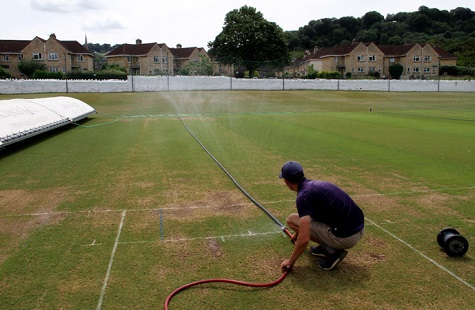
Alex watering a pitch to aid recovery
Alex is looking at the feasibility of getting an extraction licence to allow him to obtain some additional water supplies from the river Avon that runs alongside the ground. In the meantime, it is the case of making the most of what he’s got. Alex was applying water through a flat hose system that allows him to water a single pitch at a time.
While on the subject of cricket pitch preparation, you can still acquire a copy of the ECB TS4 Booklet that provides an in-depth insight into the maintenance and preparation of cricket pitches. Also the GMA have developed their cricket toolkit. Both well worth a read.